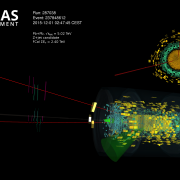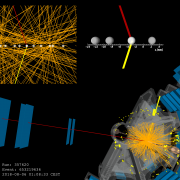Access to Collaboration Site and Physics Results

The ATLAS Collaboration has presented important new results at the European Physical Society conference on High Energy Physics (EPS-HEP) in Venice (Italy), including the latest analyses of 13 TeV Run 2 data from the Large Hadron Collider (LHC).

2016 saw the highest instantaneous luminosity for proton–proton interactions ever achieved and a staggering delivered luminosity of almost 40 fb-1. 2017 has continued on the same track, and is set to be another record year of LHC data-taking (see Figure 1).
The new data have been fertile ground for ATLAS. New insights into the Standard Model and searches for new physics are among the highlights as described below; find the full list of ATLAS public results here, with recent Run 2 results here.
A Higgs sighting, years in the making
The discovery of a new boson in 2012 by the ATLAS and CMS collaborations opened the door to countless new questions. Was this the Higgs boson as predicted by the Standard Model? Would it be a fundamental scalar particle and would it behave as predicted? Could it be a window to discovery? To conclude the nature of this new boson, ATLAS physicists have been carrying out intensive studies of its properties ever since.
One of the most critical decays of the Higgs boson was also the most common-place: H→bb, where the Higgs boson decays to a pair of b-quarks. Though it makes up over half of Higgs boson decays, there had been no evidence of it – until now. This is because its signal is difficult to distinguish, as it is usually overshadowed by overwhelming background processes that leave very similar event signatures in the detector.
The ATLAS Experiment presented evidence for a first sighting of the Higgs boson decaying to a pair of b-quarks, with an observed significance of 3.6 σ. This result combined Run 1 and Run 2 data together with many years of intense scrutiny by ATLAS teams. This evidence for H→bb fills in one of the big missing pieces of our knowledge of the Higgs sector, suggesting that the Higgs mechanism is responsible for the masses of quarks. Its sighting is an important milestone for the ATLAS Collaboration. Further precise studies with higher precision are important to look for hints of new physics beyond our current theories.


The ATLAS Experiment presented evidence for a first sighting of the Higgs decaying to a pair of b-quarks, with an observed significance of 3.6 σ.
Looking inside the Higgs boson
Since resuming operation for Run 2, the LHC has been producing roughly 20,000 Higgs bosons per day in its 13 TeV proton–proton collisions. So many, in fact, that by August 2016 the ATLAS Experiment was able to re-observe the Higgs boson using only Run 2 data. The now-familiar Higgs “bump” was seen in decays into two photons (H→γγ) and four leptons (H→ZZ*→4l, see Figure 3).
This year, these same decay channels provided ATLAS with a new measurement of the Higgs boson mass. The results are summarized in Figure 4, where the individual measurements for the two channels are given as well as their combination: 124.98 ± 0.28 GeV. New explorations of the H→γγ and H→ZZ*→4l decays have also yielded insight into the behaviour of the Higgs boson, including its coupling properties and measurements of production rates (differential cross sections). Combining both channels has allowed ATLAS to test Standard Model predictions with higher precision.

It’s lonely at the top
Observing the rare simultaneous production of multiple heavy elementary particles provides insight into how well the Standard Model describes more complex and suppressed processes. The high-energy collisions of the LHC provide a unique opportunity for experiments to spot such rare occurrences, among which the top quark – the heaviest of all fundamental particles – can be observed on its own, rather than as one of a pair, together with a boson. A new ATLAS result presented at EPS gave the first evidence of a single top quark produced in association with a Z boson (tZ).
This is an especially rare occurrence that is difficult to separate from massive background processes, with ATLAS reconstructing only 25 tZ events in over two years of data. Yet, through careful discrimination of background events from signal, the result obtained a significance of 4.2 σ. With the additional data to be collected over the next years, ATLAS will be able to study tZ production in more detail, and improve its searches for the even rarer and more elusive production of a top quark in association with a (single) Higgs boson.
A new ATLAS result presented at EPS gave the first evidence of a single top quark produced in association with a Z boson.
Searching the beyond

The ATLAS Collaboration also presented its latest results in the search for extensions to the Standard Model. A key element of these new results was their sensitivity to a wide range of new theories, including Supersymmetry and Large Extra Spatial Dimensions (LED) models.
Final states with jets and high missing transverse momentum (“mono-jets”, see Figure 5) were examined for signs of Dark Matter-candidate particles; diboson events where at least one boson decays into a pair of quarks were searched for signs of heavy new particles; and, where decays led to two tau leptons, ATLAS looked for evidence of additional SUSY Higgs bosons. While no significant deviations from the Standard Model were found in these searches, each result has helped set new limits on current theories.
The best is yet to come
Run 2 has already provided a bountiful dataset to keep ATLAS physicists busy for years to come. Its searches have extended far beyond the reach of Run 1, and are now nearing the sensitivities dreamed about at the birth of the LHC programme over 25 years ago. As the LHC continues its stellar operation, ATLAS looks forward to much deeper exploration of the 13 TeV energy frontier.
ATLAS released several Physics Briefings highlighting key new results presented at the EPS-HEP 2017 conference. Make sure to check out:
- A first LHC sighting of the Higgs boson in its favourite decay, 6 July 2017
- New rare pairs of heavy friends in ATLAS, 6 July 2017
- Why should there be only one? Searching for additional Higgs Bosons beyond the Standard Model, 6 July 2017
- New ATLAS measurement of the Higgs Boson mass, 6 July 2017
- ATLAS takes a closer look at the Higgs boson’s couplings to other bosons, 6 July 2017
- Chasing the invisible, 6 July 2017
- Probing physics beyond the Standard Model with heavy vector bosons, 8 July 2017
- See also the full lists of ATLAS Conference Notes and ATLAS Physics Papers.








